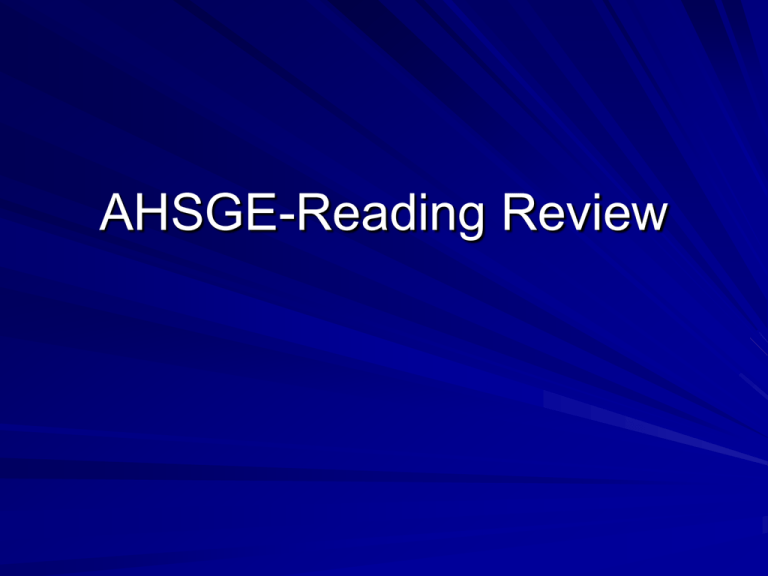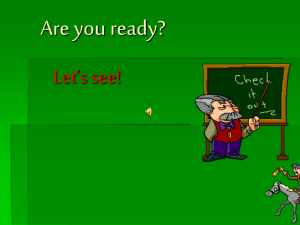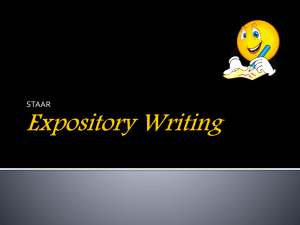AHSGE-Reading Review
advertisement

AHSGE-Reading Review Comprehension Strategies When you begin your exam.. 1. Read the passages carefully. 2. Read the questions. 3. Strategically underline important text/info 4. Go back and skim for answers-chunk information as you go. Find the topic of your paragraphs. The main idea of a selection is usually stated in the first sentence of the first paragraph, or the last sentence of the first paragraph, such as a thesis statement. Skim- Quickly skim or “speed read” through the passage stopping only at the first sentence in each paragraph. The first sentence will usually give you an idea of what the paragraph will be about. Read slowly and intently to find pertinent information after reading the questions. The key is TO READ the whole passage or section. Key Words/Clues Find Key words or clues – Each question will contain clues as to where to find answers. – Example: What caused Martin to suddenly return to Paris? – Key Words—MARTIN and PARIS – Go back and skim the passage for those key words, and the answer will be close by. Sometimes key words are not repeated in the passage. In this case, search for the general idea of the question. Numbers, years, and quotes can also serve as key words. – Example: Which of the following best describes the influence of Monet’s work in the 20th century? – Key word – 20th century Monitor your understanding Summarize as you read. Chunk your information by paragraphs. Read a paragraph; stop and make notes in the margins of your test. What is the main point in the paragraph? Underline key words or important names, dates, etc. in the paragraph. Jot down a GIST statement in the margin to help you remember what you have read. Question yourself as you read. – Why is this important to the passage? – What should I remember from this – underline or star *all important facts, details, names, events) This gives you a visual to find the info when looking for the answers. Predict what will come next Use the process of elimination. Write on your test and X out the choices you know are the wrong answers! Infer meanings- ”read between the lines” Analyzing organizational patterns and Sequence of Events Look for signal words to identify patterns – Chronological Order First, then, after, later, and finally – Cause-and-effect Order Therefore, because, subsequently, as a result – Comparison Contrast Similarly, in contrast, likewise, or on the other hand – Spatial Order-( the order of where things are) Look for prepositions—under the couch, beside the bed, around the corner Using Context Clues Look at words and sentences surrounding a new word or an unfamiliar word. Look before, at, and after the word or phrase. Connect what you know with what the author has written (background knowledge) Use context clues by looking for synonyms or antonyms nearby to determine meaning Using reference materials Dictionary, glossary, thesaurus, Internet Look for guide words at the top of the pages. Look for part of speech, definition, or synonyms, word origins. Apply the meaning to what you have read. Tips for reading graphic aids Charts, maps, tables, and diagrams PREVIEW and PREDICT the passage by reading the subtitle, title, labels, and other explanatory features Apply the labels to the graphic aid Maps include a compass rose and legend to help you interpret direction and symbols. Charts and graphs compare info in categories running horizontally and vertically. Chart 90 80 70 60 50 40 30 East West North 20 10 0 1st Qtr 2nd Qtr 3rd Qtr 4th Qtr *Remember to read ALL fine print and look for asterisks if the chart or map includes these! Previewing Passages PREVIEW-title, subtitle, key words, captions, illustrations, footnotes, etc. LOOK for bold words, italicized or underlined print. (This will give you an idea of the purpose of writing) INFER meanings based on background knowledge. Draw on past experiences and readings Propaganda/Fallacies Propaganda-uses emotional tactics to sway a reader’s opinion or to convince a reader to do something he or she may not ordinarily do. Loaded language Bandwagon Testimonial Fear Loaded Language- a common technique with specific implied or exaggerated meanings to sway a reader Our competition’s product is disgusting at best. They take chicken parts, mush them together, fry them in lard, and then deep freeze them before finally disposing of them in your stores to buy for your children! Bandwagon- uses peer pressure to convince the reader to “join the crowd” because “everyone is doing it” and you “don’t want to be left behind.” Smart shoppers insist on using Tide with bleach. It’s the smart choice for you and your family! Don’t waste your money on the other brand; no one else does! Testimonials- using a famous person to convince you to buy a product. Michael Jordan drinks Purity brand milk! It does his body good! You should drink Purity, too! Penelope Cruz is an “Easy, Breezy, Beautiful, COVER GIRL!” Fear-popular among political candidates to present dreaded circumstances and follow it up with something to prevent that horrible event. H1N1 VaccineThe WHO says that ALL Americans should take the H1N1 vaccine or face inevitable death. Literary Elements Be familiar with all literary elements studied in English class. Common elements – Simile( uses like or as) – metaphor (compares two unlike things without like or as) “The past is a bucket of ashes” – allusion ( a reference to a well known person, place, situation or character from history, music or art or literature.) “Snowball , who had studied an old book of Julius Caesar’s campaigns…” – personification- giving human qualities to something NOT HUMAN. Ex:The trees whispered a sweet lullaby. Alliteration- the repetition of initial consonant sounds EX: “And the silken, sad, uncertain rustling of each purple curtain/ Thrilled me—” from Poe’s “The Raven” Hyperbole- Extreme exaggeration Ex: Her screaming split my ears open! Theme Theme- a central message in a work of literature. – Stated theme- message is stated directly in the text. – Implied theme- revealed gradually through events, dialogue, or description. You will have to infer meaning with implied themes. – Use common sense when all else fails! Making inferences An inference involves using your reason and experience to come up with an idea based on what a writer implies or suggests, but does not directly state. Tone/mood Tone- the writer’s attitude toward his/her subject. Mood- the feeling created in you, the reader, as you read a piece of literature. Fact/Opinion Facts usually have no ambiguous words. Can be proven in some way. – For example, how long is a long time? What defines an ordinary person? Opinions may be set out in the context of words like thought, believed, understood, or wished. Drawing Conclusions Involves thinking or reasoning when all facts are not given in the text. You are using clues to discover what has happened or if it is true Think “The Cask of Amontillado” Why was Fortunato dressed like he was? Predicting Outcomes Deciding what will happen next within a story or after it has ended. We can predict that Fortunato’s punishment will be – Fitting – Mild – Moderate – Deadly**




